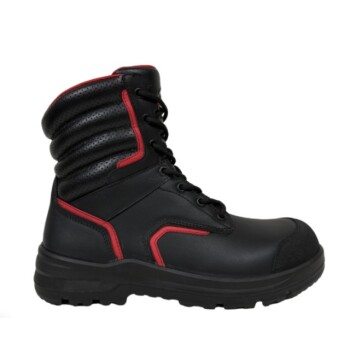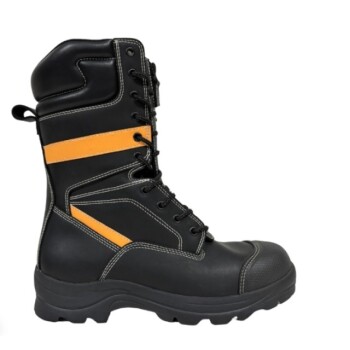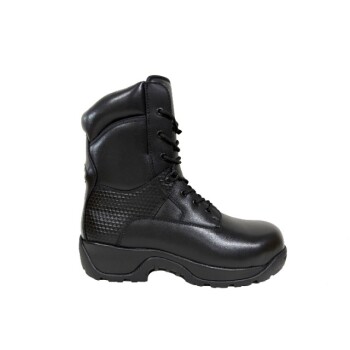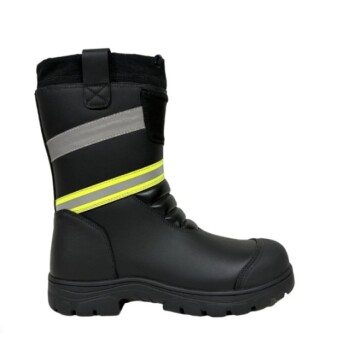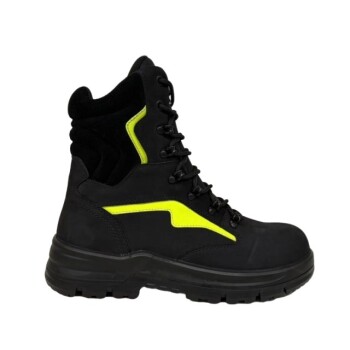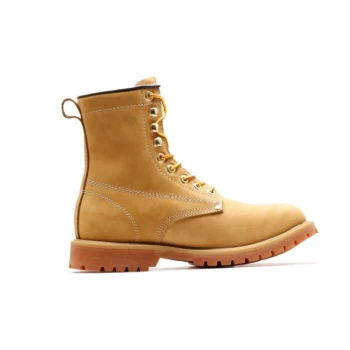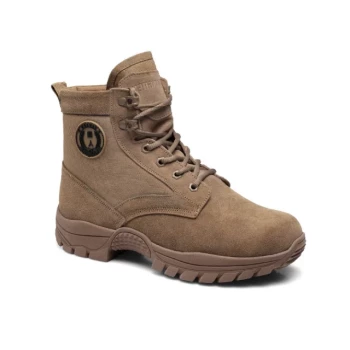Originally, the purpose of engineer boots was to serve as specialized protective equipment for steam railway engineers. Their unique laceless, pull-on design with minimal stitching was critical for protecting workers' feet and legs from the hazards of the job, such as hot coals, flying embers, and sharp metal edges in a tight engine cab.
The engineer boot was born from a specific industrial need for durable, laceless protection. While its purpose has evolved, its core design principles of safety, durability, and a secure fit continue to make it relevant for modern work and motorcycle riding.

The Anatomy of Protection
The design of an engineer boot is a direct reflection of its original purpose. Every feature was a solution to a specific environmental hazard faced by railway workers.
The Laceless, Pull-On Design
The most defining feature is the absence of laces. Laces could easily catch on machinery, get snagged on sharp objects, or be destroyed by stray embers and heat.
A simple pull-on design eliminated these risks entirely, providing a safer and more durable footwear solution for the engine room.
The Tall "Stovepipe" Shaft
Engineer boots feature a tall, unstructured shaft, typically between 10 and 12 inches high.
This provided crucial protection for the shin and lower leg against heat from the firebox and impacts from tools or equipment.
Dual Adjustment Buckles
To achieve a secure fit without laces, engineer boots use a two-buckle system.
An adjustable leather strap over the instep locks the ankle in place, while a second buckle at the top of the shaft cinches the boot to the user's calf, preventing debris from falling inside.
Heavy-Duty Materials and Construction
These boots are almost always made from thick, full-grain leather for maximum durability and heat resistance.
They were traditionally built using a Goodyear welt or stitchdown construction, creating a rugged and often resoleable boot that could withstand years of hard use.
From Railways to Roadways: The Modern Application
While steam locomotives have largely been replaced, the protective features of the engineer boot gave it a new life in other demanding environments.
The Ideal Motorcycle Boot
The engineer boot's design principles translate perfectly to the needs of motorcyclists. The tall shaft protects against engine heat and road debris, while the laceless design prevents anything from getting tangled in a bike's chain or controls.
This functional overlap is why the engineer boot has become an iconic piece of motorcycle culture.
A Staple of Rugged Workwear
Beyond motorcycles, the boot remains a viable option for any work environment where durability and protection from debris are paramount.
Its heavy-duty construction and laceless profile make it suitable for various trades where traditional laced boots might fail or present a safety hazard.
Understanding the Trade-offs
While exceptionally durable, the engineer boot is a specialized tool and is not the right choice for every situation. Understanding its limitations is key.
Not a Winter Boot
The primary purpose of an engineer boot is protection, not insulation. It is not designed to provide warmth or traction in snow and ice like a dedicated winter boot.
Not a Modern Firefighting Boot
Though originally worn by firemen on trains, they are entirely different from modern firefighting boots. They also differ from "station boots," which are lighter-duty footwear worn by firefighters for non-emergency tasks.
The Break-in Period
The thick leather and robust construction often mean a significant break-in period is required. These boots are built for longevity, not immediate, out-of-the-box comfort.
Making the Right Choice for Your Goal
Deciding if an engineer boot is right for you depends entirely on your intended use.
- If your primary focus is motorcycle safety: The engineer boot offers excellent, time-tested protection for your feet and lower legs with a classic aesthetic.
- If your primary focus is durable workwear: Its laceless design and rugged build are ideal for work environments with debris, sparks, or snag hazards.
- If your primary focus is heritage style: The boot is a timeless piece of American footwear that embodies a tough, functional, and utilitarian look.
The engineer boot endures because its design was perfected for a purpose, creating a legacy of form and function that remains relevant today.
Summary Table:
| Key Feature | Original Purpose | Modern Application |
|---|---|---|
| Laceless, Pull-On Design | Prevent snagging on machinery, avoid ember damage | Safe for motorcycle controls, no snag hazards |
| Tall Shaft (10-12 inches) | Protect shins from heat and impacts | Shield legs from engine heat and road debris |
| Dual Adjustment Buckles | Secure fit without laces, keep out debris | Customizable fit for comfort and safety |
| Heavy-Duty Leather & Construction | Withstand harsh industrial environments | Long-lasting durability for work and riding |
Need Durable, Purpose-Built Footwear for Your Business?
As a large-scale manufacturer, 3515 produces a comprehensive range of footwear for distributors, brand owners, and bulk clients. Our production capabilities encompass all types of shoes and boots, including engineer boots designed for maximum safety and durability.
Let us help you equip your customers with the right footwear for their needs. Contact us today to discuss your production requirements!
Visual Guide
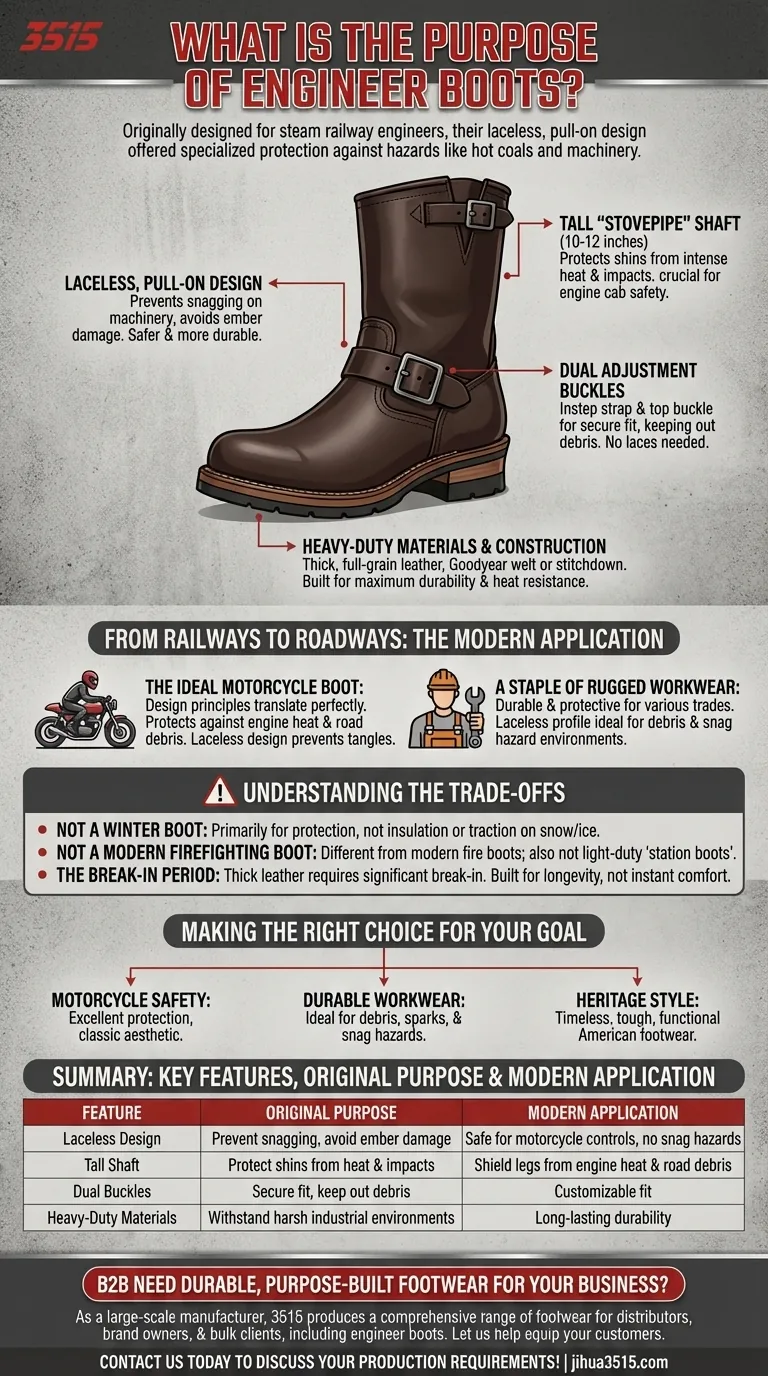
Related Products
- Safety Footwear Wholesale Manufacturer for Custom OEM/ODM Production
- Premium Wholesale Wheat Nubuck Safety Boot with Rapid Lacing System
- Premium Wholesale Waterproof Safety Boots High Performance Protection for Industrial Markets
- Premium Flame-Retardant Waterproof Safety Boots and Shoes
- Premium High-Cut Waterproof Safety Boots Manufacturing & Wholesale Solutions
People Also Ask
- What are the differences between steel toe, composite toe, and alloy toe Wellington boots? Choose the Right Safety Toe for Your Job
- What cultural and environmental considerations are tied to wearing shoes indoors? Balance Hygiene, Tradition, and Foot Health
- What are the cultural perspectives on wearing shoes in the house? A Guide to Home Etiquette & Hygiene
- What do heavy duty boots do? Protect Your Feet in Demanding Work Environments
- Is it normal to wear shoes in the house? A Guide to Hygiene, Comfort & Culture


